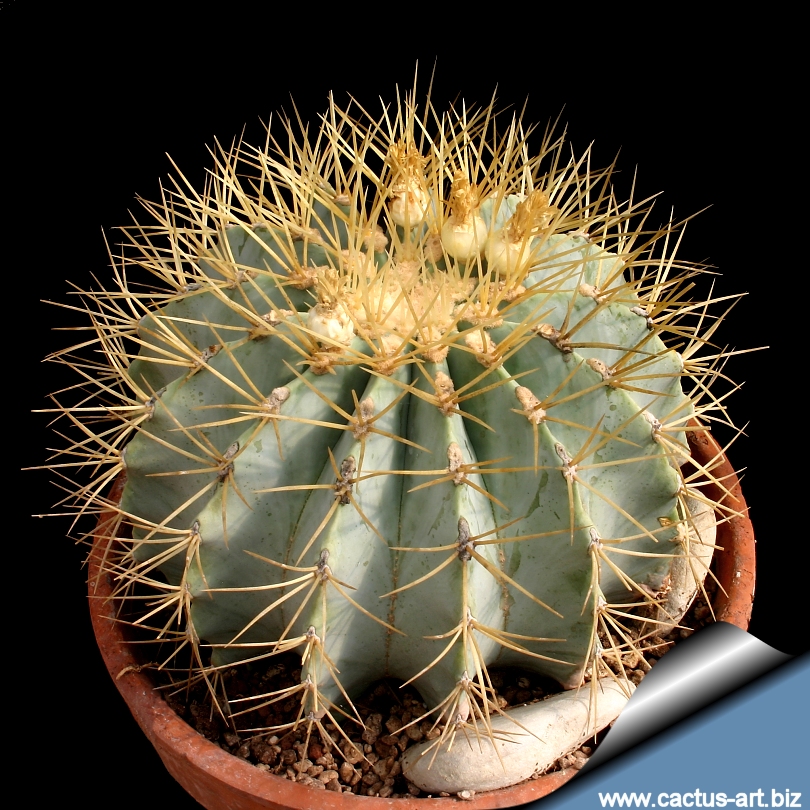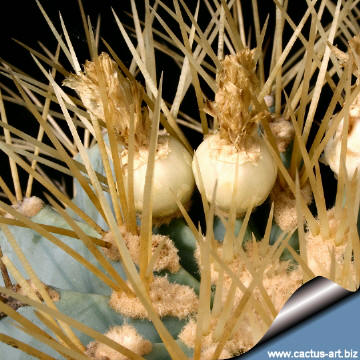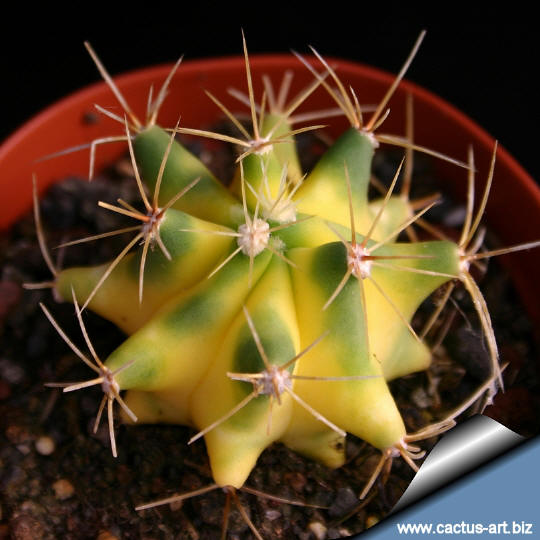|
|
|

Ferocactus glaucescens
This Ferocactus stands out from the other species. The spines are
rather neatly distributed, and the unusual-looking white fruits are
unmistakable. Though it can reach over 45 cm in diameter, it will
nonetheless flower perfectly well in an 20 cm pot.
It can be a very
neat, compact and attractive addition to any collection.
|
 |
Description:
Solitary or basally suckering, barrel cactus. Multiple heads are
produced as the plant ages and can form a very large mound.
Stems: Glaucous grey, up to 55 cm
in height, 50 cm in diameter.
Globular depressed at the apex, it becomes shortly columnar as it ages.
Ribs: 11 to 15
Radial spines: 6 or 7, 2.5-4 cm long, straight, light yellow.
Central spines: 0 or 1, very similar to the radials.
Flowers: Lemon yellow, funnel-shaped, 3-4 cm in diameter. The tepals are oblong, lanceolate, silky, shining;
the margins are finely
fringed. Stamen, style and stigma are yellow. Stigma lobes: 12-15.
Blooming season: Late spring and summer. The flowers last a very
long time. The plants start flowering when about 13
cm in diameter.
Fruit: White, 2 cm long with the remnants of the flowers
attached.
|
|
|
Cultivation: Plants are slow
growing to start, but are easy to grow and require little care once they
have reached a nice flowering size. F. glaucescens
is suited for any rich,
well drained soil in full sun, through-out the year. Pot culture:
It grows best
in a fairly roomy, well-drained container filled with a porous cactus
soil mixture that doesn't contain too much humus. To insure robust
plants, water and fertilize during the aestival growth cycle.
This plant
needs plenty of water (indicatively, about once a week).
But it's necessary to
avoid wetting the bodies of these plants while they are in sunlight. A
wet cactus in the sun light can cause sun burning which can lead to
scars, or even fungal infections and death.
In winter keep completely
dry at 10°C. This usually aids in maintaining a healthier plant, but
it can
tolerate sporadic light frost.
Photo of conspecific taxa, varieties,
forms and cultivars of plants belonging to the Ferocactus
pottsii
complex (This
Taxon has lots of synonyms ( like
many other cacti) whit controversial varieties and subspecies:


|
|
Advertising
|
|
|
|
|
Family:
Cactaceae (Cactus
Family)
Scientific name:
Ferocactus
glaucescens (DC.) Britton & Rose
Origin: Eastern central Mexico, Hidalgo
(Meztitlan, Toliman and Jacala)
Habitat: This species
is found within the numerous limestone hills and boulders at several
locations in the state of Hidalgo, Mexico. It has been noted to favor
the more northern slopes, and the plants are well associated with the
rocky, juniper woodland community, up to around 1200 m
in elevation.
Conservation status: Listed in
CITES appendix 2.
Common Name: Blue Barrel Cactus
Synonyms:
- Bisnaga glaucescens
- Echinocactus
glaucescens
-
Echinocactus pfeifferi
- Ferocactus pfeifferi
(This
Taxon belong to a group of six closely
allied species. The group is:
F. alamosanus,
F. pottsii,
F. schwarzii,
F. reppenhagenii, F.
glaucescens, & F. echidne)
|
|
|
|

The glaucous (blue grey-green) appearance of this barrel with the nice
light golden spines makes it very easy to identify.
Reproduction: Seeds are the typical way
of reproducing. These cacti will easily grow from seeds and some from
cuttings. Seeds can be sown in the spring or summer in well-drained pots
of soil for cacti. Sow the seeds thinly on top. Cover them with a bit
of fine quartz grit. Moisten and lay a piece of glass across the top.
The pots should be set in a warm greenhouse until they start to sprout,
after which the glass should be progressively removed so they can
receive full light and air. It isn't good to keep the glass over the
seedlings. The well developed seedlings can be planted separately in
small pots.
Cuttings made from pieces of the stem of any size can be detached and
laid aside for a few days to allow a protective "skin" to form over the
cut. They can then be planted in pots. Place them in a spot where
they'll receive sun, and do not water until the soil becomes fairly dry.
After a while the soil can be moistened regularly, but never kept
constantly saturated.

A variegated seedling.
|
|